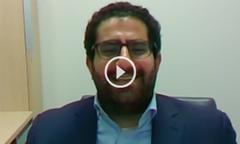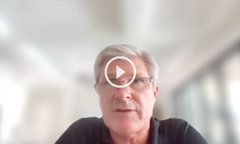
Strategies for Managing Adverse Events of Osimertinib for EGFR+ NSCLC
Jonathan W. Goldman, MD, discusses management of the most common adverse events associated with osimertinib in patients with non–small cell lung cancer.
Episodes in this series

Jonathan W. Goldman, MD, associate professor of medicine in the hematology/oncology division, director of clinical trials in thoracic oncology, and the associate director of early drug development at UCLA Health, discusses management of the most common adverse events (AEs) associated with osimertinib (Tagrisso) in patients with non–small cell lung cancer.
Goldman says that osimertinib is generally well tolerated compared with other agents in this space. It has less incidence of severe rash than the previously used EGFR inhibitors erlotinib (Tarceva) and gefitinib (Iressa), which osimertinib was compared with in the FLAURA trial (NCT02296125).
Approximately 10% of patients require supportive care for diarrhea; Goldman suggests giving patients loperamide (Imodium) and making sure they have it on hand. Paronychia infecting the skin of the fingers or toes can be another challenge. He says a podiatrist can be consulted for paronychia of the feet and they are often effective at controlling this toxicity. For the hands or in general, patients can manage paronychia with moisturizer, or soak with saltwater Epsom salts. They can also cover the area affected or use ointment such as petroleum jelly.
TRANSCRIPTION:
0:08 | Osimertinib is in general an easy therapy for most patients to tolerate in the metastatic setting.... Compared [with] other EGFR inhibitors, we tend to see less rash and that was really the most significant challenge for most patients on the previous drugs erlotinib or gefitinib, so that was a welcome change.
We still do see diarrhea that needs management in about 10% of patients. There we use typically loperamide for patients and I often ask patients to have it on hand, especially if they're leaving town or something like that, so they're ready to treat that.
0:53 | Paronychia can be challenging, sometimes painful and difficult in some circumstances to completely control. If there's any paronychia of the feet, I do very frequently get a podiatrist involved; they're often very successful at treating it. Of the hands, sometimes not quite the same opportunity to get other specialists involved, but keeping the hands off with a moisturizer, sometimes, saltwater [or] Epsom salt soaks can be helpful; Band-Aids and covering the area if it gets particularly inflamed, and occlusive ointment, as simple as Vaseline or something with antibiotics can be helpful as well. And those are really the most common [AEs] that we see.

















































